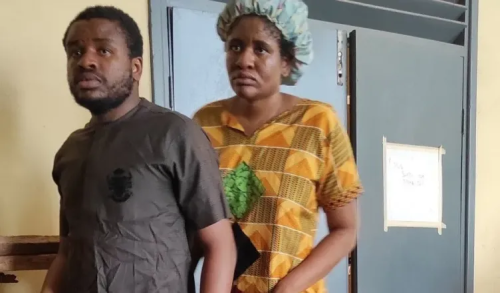Crime
The Role of Last Seen Doctrine in the Murder Trial of Chiamaka Ifezue
The doctrine of last seen: How Justice Was Served in the Conviction of the Killer of Enugu Makeup Artist

In a landmark ruling by Justice Kenneth Okpe of the Enugu State High Court, justice has been served in the case of the brutal murder of Ms Ijeoma Nneke, a talented Nigerian makeup artist. Chiamaka Ifezue, the perpetrator of this heinous crime, has been sentenced to death by hanging, bringing closure to a case that has gripped the nation with its tragic details.
The prosecution, led by Ms Chinelo Chigbo from the Department of Public Prosecutions (DPP), meticulously presented evidence that left no doubt about Ifezue’s guilt. The doctrine of last seen played a pivotal role in establishing her culpability, demonstrating that Ifezue was the last person seen with the victim before her untimely demise.

The Importance of Speaking Out Against Injustice: The Pharmacist Who Testified Against the Killer of Enugu Makeup Artist
One particularly damning piece of evidence was Ifezue’s attempt to silence a pharmacist who supplied the lethal drug used in the murder. Despite offering £100 to keep quiet, the pharmacist courageously testified against Ifezue in court, contributing to the irrefutable case against her.
Furthermore, the court uncovered the extent of Ifezue’s premeditation, revealing her elaborate plan to carry out the murder. From instructing her domestic help to register a SIM card used in the crime to fabricating a false identity to deceive the victim, Ifezue’s actions were calculated and cold-blooded.
A Sister’s Quest for Justice: The Story of Aku Nneke and Her Late Sister’s Murder Case
Chiamaka Ifezue’s conviction serves as a reminder that justice will prevail, even in the face of attempts to obstruct the truth. While nothing can bring back the life that was senselessly taken, the ruling brings solace to the grieving family of Ijeoma Nneke. As her elder sister, Aku Nneke, expressed, the judgment may not erase their pain but reaffirms their faith in the judicial system as the last bastion of hope for the common man.

As the nation reflects on this tragic case, let it serve as proof of the uncompromising obligation of law enforcement and the judiciary to uphold justice and hold perpetrators accountable for their actions. May the memory of Ijeoma Nneke live on, and may her family find strength and closure in the knowledge that her killer has been brought to justice.
The Impact of Technology in Solving the Murder of Ijeoma Nneke
The Doctrine of Last Seen states that the person last seen with a deceased bears full responsibility for his or her death. For example, if Mrs Katharina Rostova was last seen alive with or in the company of Mr Raymond Reddington and the next thing that happened was the disappearance of Katharina, the irresistible inference is that she was or had been killed by Reddington.
This doctrine is one of the fundamental principles of Nigerian Criminal Jurisprudence, and it is mostly used in murder and manslaughter cases. By extension, this theory is not restricted to the Nigerian Criminal Jurisprudence alone. It is a principle of universal application. See the Indian case of Rajashkhanna v State of A.P. (2006) 10 SCC 172.

How Justice Was Served in the Conviction of the Killer of Enugu Makeup Artist
Although the Nigerian statutes and laws do not provide for this doctrine, it has gained notoriety in criminal jurisprudence through various judicial pronouncements.
Commenting on this doctrine, the Apex court per Adekeye, J.S.C, (as he then was) in Haruna v. AG of Federation (2012) LPELR-SC.72/2010,(Pp. 30-31, paras. F-B) held that: “The doctrine of “last seen” means that the law presumes that the person last seen with a deceased bears full responsibility for his death. Thus, where an accused person was the last person to be seen in the company of the deceased and circumstantial evidence is overwhelming and leads to no other conclusion, there is no room for acquittal. The appellant must give an explanation relating to how the deceased met her death in such circumstances. In the absence of a satisfactory explanation, a trial court and an appellate court will be justified in drawing the inference that the accused person killed the deceased.

The Doctrine of Last Seen thrives on presumption; it is rebuttable like every presumption in law. Generally, the trite principle of law is that the burden of proof is always on the prosecution to prove the accused person’s guilt beyond reasonable doubt through credible and reliable evidence in proof of the case against the accused person. See Section 135 of the Evidence Act 2011. However, under the Doctrine of Last Seen, this general principle changes, and the burden of proof thus shifts from the prosecution to the accused to adduce credible evidence to show that he or she was not the one who killed the deceased.
In the case of Madu v. State (2012) LPELR-SC.12/2009, the court held: “If it turns out that the person last seen with the deceased is dead, the doctrine, therefore, lays a burden on the accused to give an explanation on how the deceased met his or her death.”
It is pertinent to state that in determining the guilt or otherwise of the accused, attention is heavily placed on the time gap by the Courts. Suppose the time when the accused and the deceased were last seen alive, and the deceased is found dead. In that case, it is so infinitesimal that the possibility of anyone other than the accused coming in contact with the deceased becomes impossible; the doctrine may likely be applied. However, in some cases, it would be difficult to successfully establish that the deceased was last seen with the accused when there is a long gap and the possibility exists of other persons coming in between.

Furthermore, this doctrine is not meant to be applied in isolation. In addition, there must also be overwhelming circumstantial evidence pointing to the accused’s guilt. Circumstantial evidence in criminal law is the proof of circumstances from which, according to the ordinary course of human affairs, the existence of some fact may reasonably be presumed.
Owing to this, the principle was not applicable in the 2019 recent case of State v. Sunday (2019) LPELR-SC.709/2013 involving the alleged murder of a father by his son, while it was applicable in Anyasodor v. State (2018) LPELR-SC.655/2015 involving the death of a man through his estranged lover. Hence, the applicability depends on the facts of each case and the circumstantial evidence. The rationale behind this is to avert the miscarriage of justice.
ATTENTION:
Unauthorized use and/or duplication of this material and other digital content on this website, in whole or in part, without express and written permission from Legal Attorney Blog is strictly prohibited.
Exciting news! The Legal Attorney Blog is now on WhatsApp Channels. Subscribe today by clicking the link and staying updated with the latest legal news.
Related topics:
NBA | Judiciary | Ethics | Career & Practice | Public Interest |
You might also like:



Click Button Below to Join Our Telegram Groups

For Advert Inquiries & News/Article Publishing
Call:+2348033888791, +2347069999005
E-mail: legalattorneyblog01@gmail.com









